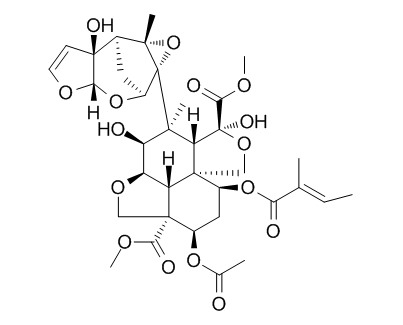Azadirachtin
Azadirachtin has antifungal activity, it used as insecticides.
Inquire / Order:
manager@chemfaces.com
Technical Inquiries:
service@chemfaces.com
Tel:
+86-27-84237783
Fax:
+86-27-84254680
Address:
1 Building, No. 83, CheCheng Rd., Wuhan Economic and Technological Development Zone, Wuhan, Hubei 430056, PRC
Providing storage is as stated on the product vial and the vial is kept tightly sealed, the product can be stored for up to
24 months(2-8C).
Wherever possible, you should prepare and use solutions on the same day. However, if you need to make up stock solutions in advance, we recommend that you store the solution as aliquots in tightly sealed vials at -20C. Generally, these will be useable for up to two weeks. Before use, and prior to opening the vial we recommend that you allow your product to equilibrate to room temperature for at least 1 hour.
Need more advice on solubility, usage and handling? Please email to: service@chemfaces.com
The packaging of the product may have turned upside down during transportation, resulting in the natural compounds adhering to the neck or cap of the vial. take the vial out of its packaging and gently shake to let the compounds fall to the bottom of the vial. for liquid products, centrifuge at 200-500 RPM to gather the liquid at the bottom of the vial. try to avoid loss or contamination during handling.
Front Cell Dev Biol.2021, 9:764263.
Int J Mol Sci.2023, 24(24):17589.
Kyung Hee University2024, rs-3888374
Phytochem Anal.2024, pca.3319.
BMC Pharmacol Toxicol.2018, 19(1):5
J Agric Food Chem.2021, 69(46):14037-14047.
Molecules.2024, 29(6):1240.
Food Chem X.2024, 21:101208.
Chem Biol Interact.2016, 258:59-68
Antioxidants (Basel).2022, 11(10):1929.
Related and Featured Products
Annu Rev Entomol. 2019 Oct 8.
Botanical Insecticides in the Twenty-First Century-Fulfilling Their Promise?[Pubmed:
31594414]
METHODS AND RESULTS:
Academic interest in plant natural products with insecticidal properties has continued to grow in the past 20 years, while commercialization of new botanical insecticides and market expansion of existing botanicals has lagged considerably behind. Insecticides based on pyrethrum and neem (Azadirachtin) continue to be standard bearers in this class of pesticides, but globally, their increased presence is largely a consequence of introduction into new jurisdictions. Insecticides based on plant essential oils are just beginning to emerge as useful plant protectants. Some countries (such as Turkey, Uruguay, the United Arab Emirates, and Australia) have relaxed regulatory requirements for specific plant extracts and oils, while in North America and the European Union, stricter requirements have slowed progress toward commercialization of new products.
CONCLUSIONS:
Botanicals are likely to remain niche products in many agricultural regions and may have the greatest impact in developing countries in tropical regions where the source plants are readily available and conventional products are both expensive and dangerous to users.
Toxins (Basel). 2019 Oct 5;11(10). pii: E579.
In Vitro Activity of Neem (Azadirachta indica) Oil on Growth and Ochratoxin A Production by Aspergillus carbonarius Isolates.[Pubmed:
31590398]
Aspergillus carbonarius is a saprobic filamentous fungus, food spoiling fungus and a producer of ochratoxin A (OTA) mycotoxin.
METHODS AND RESULTS:
In this study, the in vitro antifungal activity of neem oil (0.12% p/p of Azadirachtin) was evaluated against the growth of six strains of A. carbonarius and the production of OTA. Four different concentrations of neem oil were tested in addition to three incubation times. Only the concentration of 0.3% of neem oil inhibited more than 95% of the strain's growth (97.6% ± 0.5%), while the use of 0.5% and 1.0% of neem oil showed lower antifungal activity, 40.2% ± 3.1 and 64.7% ± 1.1, respectively. There was a complete inhibition of OTA production with 0.1% and 0.3% neem oil in the four strains isolated in the laboratory from grapes.
CONCLUSIONS:
The present study shows that neem essential oil can be further evaluated as an auxiliary method for the reduction of mycelial growth and OTA production.



